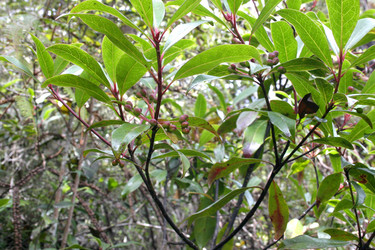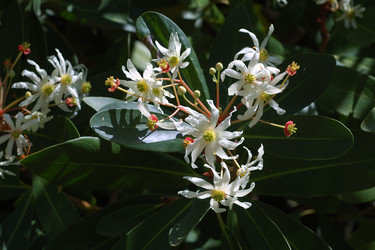Canellales



This tree diagram shows the relationships between several groups of organisms.
The root of the current tree connects the organisms featured in this tree to their containing group and the rest of the Tree of Life. The basal branching point in the tree represents the ancestor of the other groups in the tree. This ancestor diversified over time into several descendent subgroups, which are represented as internal nodes and terminal taxa to the right.

You can click on the root to travel down the Tree of Life all the way to the root of all Life, and you can click on the names of descendent subgroups to travel up the Tree of Life all the way to individual species.
For more information on ToL tree formatting, please see Interpreting the Tree or Classification. To learn more about phylogenetic trees, please visit our Phylogenetic Biology pages.
close boxReferences
Carlquist, S. 2000. Wood and bark anatomy of Takhtajania (Winteraceae); Phylogenetic and ecological implications. Annals of the Missouri Botanical Garden 87:317-322.
Doust, A. N. 2000. Comparative floral ontogeny in Winteraceae. Annals of the Missouri Botanical Garden 87:366-379.
Doyle, J. A. 2000. Paleobotany, relationships, and geographic history of Winteraceae. Annals of the Missouri Botanical Garden 87: 303-316.
Doyle, J. A., C. L. Hotton and J. V. Ward. 1990. Early Cretaceous tetrads, zonasuculate pollen and Winteraeae. I. Taxonomy, morphology, and ultrastructure. American Journal of Botany 77:1544-1557.
Doyle, J. A., C. L. Hotton and J. V. Ward. 1990. Early Cretaceous tetrads, zonasuculate pollen, and Winteraceae. II. Cladistic analysis and implications. American Journal of Botany 77:1558-1568.
Ehrendorfer, F. and M. Lambrou. 2000. Chromosomes of Takhtajania, other Winteraceae, and Canellaceae: Phylogenetic implications. Annals of the Missouri Botanical Garden 87:407-413.
Endress, P. K., A. Igersheim, F. B. Sampson, and G. E. Schatz. 2000. Floral structure of Takhtajania and its systematic position in Winteraceae. Annals of the Missouri Botanical Garden 87:347-365.
Feild, T. S., T. Brodribb, and M. Holbrook. 2002. Hardly a relict: Freezing and the evolution of vesselless wood in winteraceae. Evolution 56:464-478.
Feild, T. S., M. A. Zwieniecki, and M. Holbrook. 2000. Winteraceae evolution: An ecophysiological perspective. Annals of the Missouri Botanical Garden 87:323-334.
Karol, K. G., Y. B. Suh, G. E. Schatz, and E. A. Zimmer. 2000. Molecular evidence for the phylogenetic position of Takhtajania in the Winteraceae: Inference from nuclear ribosomal and chloroplast gene spacer sequences. Annals of the Missouri Botanical Garden 87:414-432.
Sampson, F. B. 2000. The pollen of Takhtajania perrieri (Winteraceae). Annals of the Missouri Botanical Garden 87:380-388.
Schatz, G. E., P. P. Lowry, and A. Ramisamihantanirina. 1998. Takhtajania perrieri rediscovered. Nature 391:133-134.
Suh, Y., L. B. Thien, H. E. Reeve and E. A. Zimmer. 1993. Molecular evolution and phylogenetic implications of internal transcribed spacer sequences of ribosomal DNA Winteraceae. American Journal of Botany 80:1042-1055.
Tobe, H. and B. Sampson. 2000. Embryology of Takhtajania (Winteraceae) and a summary statement of embryological features for the family. Annals of the Missouri Botanical Garden 87:389-397.
Van der Ham, R., and B. J. Van Heuven. 2002. Evolutionary trends in Winteraceae pollen. Grana 41:4-9.
Vink, W. 1988. Taxonomy in Winteraceae. Taxon 37:691-698.
Vink, W. 1993. Winteraceae. Pages 630-638 in: The Families and Genera of Vascular Plants. II. Flowering Plants: Dicotyledons, Magnoliid, Hamamelid and Caryophyllid Families. K. Kubitzki, J. G. Rohwer, and V. Bittrich, eds. Springer, Berlin.
Walker, J. W., G. J. Breener, and A. G. Walker. 1983. Winteraceaeous pollen in the Lower Cretaceous of Israel: early evidence of a magnolialean angiosperm family. Science 220:1273-1275.
Title Illustrations

| Scientific Name | Tasmannia |
|---|---|
| Location | Mt Kinabalu. Edge of low-altitude rainforest not far from Park entrance, Borneo |
| Specimen Condition | Live Specimen |
| Source | Tasmannia sp. 041003-2025 |
| Source Collection | Flickr |
| Image Use |
 This media file is licensed under the Creative Commons Attribution-NonCommercial-ShareAlike License - Version 2.0. This media file is licensed under the Creative Commons Attribution-NonCommercial-ShareAlike License - Version 2.0.
|
| Copyright | © 2004 Tony |
| Scientific Name | Drimys winteri |
|---|---|
| Location | cultivated at UC Berkeley Botanical Garden |
| Specimen Condition | Live Specimen |
| Source | Drimys winteri |
| Source Collection | Flickr |
| Image Use |
 This media file is licensed under the Creative Commons Attribution-NonCommercial-NoDerivs License - Version 2.0. This media file is licensed under the Creative Commons Attribution-NonCommercial-NoDerivs License - Version 2.0.
|
| Copyright | © 2006 Eric in SF |
About This Page
Page copyright © 2002
 Page: Tree of Life
Canellales.
The TEXT of this page is licensed under the
Creative Commons Attribution-NonCommercial License - Version 3.0. Note that images and other media
featured on this page are each governed by their own license, and they may or may not be available
for reuse. Click on an image or a media link to access the media data window, which provides the
relevant licensing information. For the general terms and conditions of ToL material reuse and
redistribution, please see the Tree of Life Copyright
Policies.
Page: Tree of Life
Canellales.
The TEXT of this page is licensed under the
Creative Commons Attribution-NonCommercial License - Version 3.0. Note that images and other media
featured on this page are each governed by their own license, and they may or may not be available
for reuse. Click on an image or a media link to access the media data window, which provides the
relevant licensing information. For the general terms and conditions of ToL material reuse and
redistribution, please see the Tree of Life Copyright
Policies.
Citing this page:
Tree of Life Web Project. 2002. Canellales. Version 01 January 2002 (temporary). http://tolweb.org/Canellales/20673/2002.01.01 in The Tree of Life Web Project, http://tolweb.org/









 Go to quick links
Go to quick search
Go to navigation for this section of the ToL site
Go to detailed links for the ToL site
Go to quick links
Go to quick search
Go to navigation for this section of the ToL site
Go to detailed links for the ToL site